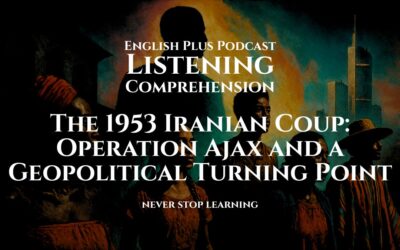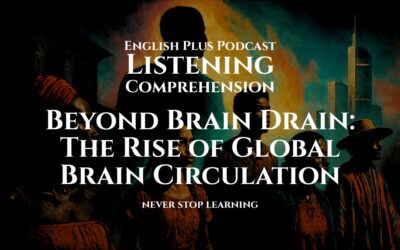Listen Closely: Understanding Economic Theories
Welcome to your next listening challenge, designed for those preparing for the rigorous listening sections of international exams. Today’s topic, economic theories, requires you to follow complex arguments, understand cause-and-effect relationships, and distinguish between different schools of thought.
Here are some targeted tips for this kind of academic lecture:
- Map the Arguments: As you listen, try to create a mental map. Who are the key figures? What are their main ideas? How do their theories contrast with each other? Note-taking can be very helpful here—a simple “Keynes vs. Hayek” T-chart could do wonders.
- Listen for Definitions: When the lecturer introduces a new term like “aggregate demand” or “fiscal policy,” they will almost always provide a definition or explanation. Be ready to capture that explanation.
- Track the Timeline: This lecture discusses the evolution of ideas. Listen for time markers (“In the 1930s…”, “Following the stagflation of the 70s…”, “More recently…”) to keep the historical development straight.
- Connect Theory to Events: The best way to understand these abstract theories is through the real-world examples given. Pay close attention when the lecturer mentions events like the Great Depression or the 2008 financial crisis.
You are about to hear a lecture from an economics course.
Listen
Transcript
Listening Transcript: Please do not read the transcript before you listen and take the listening comprehension quiz.
Good morning. Over the past few weeks, we’ve laid the groundwork for understanding microeconomics. Today, we’re shifting our perspective to the macro level. We’ll be tracing the evolution of the major economic theories that have shaped government policy and our global financial system for the last century, beginning with the man who arguably invented modern macroeconomics: John Maynard Keynes.
Before the 1930s, classical economic theory reigned supreme. It held that a free market economy was a self-correcting mechanism. If there was unemployment, wages would fall until everyone was hired. If there was a downturn, prices would adjust, and the economy would naturally return to full employment. This was the doctrine of laissez-faire. The Great Depression shattered this belief. As unemployment soared to over 25% in the United States and economies worldwide collapsed, it became painfully clear that the market was not correcting itself.
This is where Keynes stepped in. In his 1936 masterpiece, “The General Theory of Employment, Interest and Money,” Keynes offered a radical diagnosis. He argued that the core problem was a lack of aggregate demand—that is, the total demand for goods and services in an economy. In a downturn, he explained, a vicious cycle can take hold: people lose jobs, so they spend less, which causes businesses to cut back further, leading to more job losses. The economy can get stuck in a prolonged slump.
Keynes’s prescription was equally radical for its time. He argued that to break the cycle, the government must step in. Through what we now call fiscal policy, the government could increase its spending—on public works projects, for example—or cut taxes to give people more money to spend. This injection of demand would stimulate the economy, creating jobs and restoring confidence. For several decades following World War Two, this Keynesian model dominated economic policy in the Western world, a period of unprecedented economic growth and stability.
However, by the 1970s, Keynesianism faced a crisis of its own. Economies began to experience something the theory couldn’t easily explain: stagflation. That is, a combination of stagnant economic growth and high inflation. Keynesian policies designed to boost demand seemed to only fuel more inflation without fixing the unemployment problem. This opened the door for a powerful counter-revolution in economic thought, led by figures like Friedrich Hayek and, most prominently, Milton Friedman.
Friedman was the leading figure of the “Chicago School” of economics and a champion of monetarism. He argued that the Keynesian focus on government spending was misguided and often harmful. For Friedman, the key to a stable economy was controlling the money supply. He argued that inflation was always and everywhere a monetary phenomenon, caused by too much money chasing too few goods. The solution, therefore, was not activist fiscal policy, but a steady, predictable growth in the money supply, managed by a central bank. Friedman’s ideas were hugely influential, shaping the policies of leaders like Margaret Thatcher in the UK and Ronald Reagan in the US during the 1980s, leading to an era of deregulation, privatization, and a reduced role for the state.
For much of the late 20th and early 21st centuries, a sort of synthesis emerged, sometimes called the “New Neoclassical Synthesis,” which blended elements of both Keynesian and monetarist thought. It accepted the Keynesian idea that economies can deviate from their potential in the short run but held to the classical view that they are self-correcting in the long run. The primary tool for managing the economy became monetary policy, specifically the adjustment of interest rates by independent central banks.
Then came the 2008 global financial crisis. The sheer scale of the collapse and the inability of conventional monetary policy—like cutting interest rates to zero—to fix the problem led to a major re-evaluation. Suddenly, Keynes was back in fashion. Governments around the world unleashed massive fiscal stimulus packages, a direct application of Keynesian principles. The crisis also gave rise to new and more critical perspectives. Behavioral economics, for example, which had been developing for decades, gained prominence. It challenges the classical assumption that humans are always rational economic actors, incorporating insights from psychology to better understand financial manias and panics.
More recently, you may have heard of a theory called Modern Monetary Theory, or MMT. MMT pushes Keynesian ideas even further, arguing that for a country that controls its own currency, the government is not constrained in its spending in the way a household is. According to MMT, such a government can’t go bankrupt in its own currency, and the primary limit on its spending is not a budget deficit, but inflation. This is a controversial theory, but its ideas have entered the mainstream debate, especially in discussions about funding large-scale projects like a Green New Deal or responding to crises like the COVID-19 pandemic.
So, where does that leave us? Today’s economic landscape is a complex tapestry woven from the threads of all these theories. The debate between intervention and free markets, fiscal and monetary policy, is as alive as ever. Understanding the journey from Keynes’s focus on demand, to Friedman’s on the money supply, and on to the new ideas emerging today, is essential for grasping the forces that shape our modern world.
Listening Comprehension Quiz
Key Vocabulary and Phrases
- Laissez-faire:
- What it means: A French term that literally means “let do.” In economics, it refers to a policy of minimum governmental interference in the economic affairs of individuals and society.
- How it was used: The lecture used this term to describe the “doctrine” of classical economics before the Great Depression, which held that markets would fix themselves.
- Aggregate Demand:
- What it means: The total demand for final goods and services in an economy at a given time.
- How it was used: The lecturer explained that this was the core of Keynes’s theory; he believed a lack of aggregate demand was the cause of economic slumps.
- Fiscal Policy:
- What it means: The use of government revenue collection (mainly taxes) and expenditure (spending) to influence a country’s economy.
- How it was used: This was presented as Keynes’s main solution. The government could use fiscal policy (e.g., spending on public works) to increase aggregate demand.
- Stagflation:
- What it means: A combination of stagnant (low or zero) economic growth, high unemployment, and high inflation.
- How it was used: The lecturer explained that the stagflation of the 1970s was a crisis for Keynesian theory because its policies seemed to make inflation worse without fixing unemployment.
- Monetarism:
- What it means: An economic theory that focuses on the money supply and central banking as the key to controlling the economy. It argues that controlling the money supply is the best way to manage inflation.
- How it was used: This was presented as the counter-revolution to Keynesianism, led by Milton Friedman.
- Monetary Policy:
- What it means: The actions undertaken by a central bank to manipulate the money supply and credit conditions to stimulate or restrain economic activity. The most common tools are setting interest rates and quantitative easing.
- How it was used: The lecture contrasted this with fiscal policy, noting it was the preferred tool of monetarists and the “New Neoclassical Synthesis.”
- Behavioral Economics:
- What it means: A field of economics that incorporates insights from psychology to understand how and why people make certain economic choices. It challenges the idea that people are always rational.
- How it was used: The lecturer mentioned that this field “gained prominence” after the 2008 crisis because it helped explain irrational financial behavior like panics.
- Modern Monetary Theory (MMT):
- What it means: A controversial economic theory that suggests monetarily sovereign countries (like the US, UK, Japan) can’t go broke in their own currency and can afford to buy anything for sale in that currency. The main constraint is inflation.
- How it was used: This was introduced as a recent, and more radical, theory that is influencing current debates about government spending.
- Counter-revolution:
- What it means: A movement or action that seeks to reverse the effects of a previous revolution or major change.
- How it was used: The lecturer described the rise of monetarism in the 1970s as a “powerful counter-revolution” against the dominant Keynesian ideas.
- Tapestry:
- What it means: Used metaphorically, it means a complex situation or object made up of many different, interconnected parts.
- How it was used: The lecturer concluded that today’s economic landscape is a “complex tapestry woven from the threads of all these theories,” meaning it’s an intricate mix of these different ideas.










0 Comments